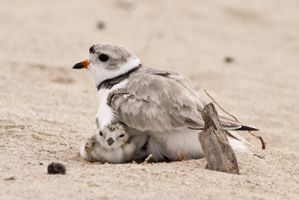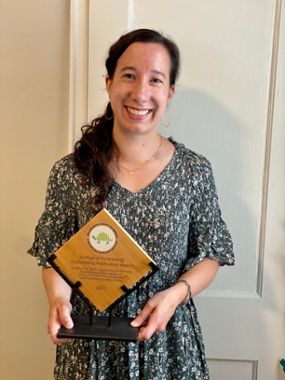MSU ecologists receive award for endangered species forecasting work

A few years ago, Michigan State University quantitative ecologists Sarah Saunders and Elise Zipkin created a new statistical model to understand the threats endangered species face. Now, as federal agencies continue to use those findings, the research has earned this year’s Ecological Forecasting Outstanding Publication Award from the Ecological Society of America (ESA).
When the U.S. Fish and Wildlife Service needed help boosting the Great Lakes population of piping plovers, Saunders, then a postdoctoral researcher in Zipkin’s Quantitative Ecology Lab, teamed up with Zipkin to uncover threats to the endangered shorebird’s recovery. Saunders developed an analysis framework to estimate and predict the numbers of endangered plovers based on environmental variables.
Their award-winning paper, published in the Journal of Applied Ecology in 2018, combines Saunders’ work on statistical modeling during her postdoc, along with her Ph.D. research on piping plovers, and makes a strong case for predator control.

“As we developed this project, I was able to take my two passions, ornithology and quantitative ecology, and put them together,” said Saunders, now a conservation biologist in the Science Division of the National Audubon Society and the paper’s lead author. “It’s an honor to be recognized for this work not only because it addresses an important conservation issue, but also because this paper synthesizes a lot of my accomplishments as a grad student and then as a postdoc.”
The scientific achievement lies in how the statistical model used 24 years of different data streams on plover demography and abundance in the Great Lakes region to project the future size of the population while taking multiple sources of uncertainty and potential management actions into account.
“This paper demonstrates a creative way of integrating various available data sources to understand the past and predict what might happen in the future to an imperiled species under different conservation scenarios,” said Zipkin, associate professor in the College of Natural Science’s Department of Integrative Biology, director of the Ecology, Evolution, and Behavior Program (EEB), and the paper’s senior author. “It’s innovative science with important real-world applications.”

The ESA’s Statistical Ecology Section established the publication award in 2017 to recognize one outstanding scholarly publication each year in the emerging field of ecological forecasting. By taking what is already known about the natural world and incorporating uncertainties about what the future may bring, ecological forecasting gives policy makers and conservation managers a basic understanding of the future trajectories of ecological systems and a better chance at protecting biodiversity and natural systems.
“The awards committee was impressed by the paper's balance of simultaneously providing managers with timely and decision relevant predictions about a federally endangered species, improving our basic science understanding of plover population processes and predator-prey dynamics more generally and developing important methodological advancements that are applicable to a wide range of other population management problems,” said Michael Dietze, professor at Boston University, chair of the ESA Ecological Forecasting Award Committee and founding director/steering committee chair for the Ecological Forecasting Initiative.
Since the paper found that a population of predators would likely continue to increase, leading to a smaller number of plovers, the U.S. Fish and Wildlife service has adapted their control of merlins, the primary avian predator of adult plovers, at nesting locations throughout the Great Lakes.
“Forecasting is important, especially with endangered species, because managers deal with so much uncertainty every day,” Saunders said. “Uncertainty makes it hard for managers to confidently make decisions. With this modeling approach, we were able to provide them with probabilities of future population change based on management options, helping to guide them in the right direction.”
The predator control strategy is producing promising results. This year, one of the merlin-controlled sites hit a record number of fledged plovers. As scientists work toward piping plover recovery goals, the hope is that the statistical methods used in this research could be applied to management of other endangered species.
Francesca Cuthbert, professor at the University of Minnesota and leader of Great Lakes piping plover recovery efforts for more than 30 years, was a co-author on the paper.
Banner image: Great Lakes piping plover adult and chicks. As scientists work toward piping plover recovery goals, the hope is that the statistical methods used in this research could be applied to management of other endangered species.Credit: Roger Eriksson